 Monarch
Butterflies
Monarch
Butterflies
Celebrate Valentine’s Day!
Hollow | Legend | Winter | Spring | Easter | Summer | Fall | Angel | Play | Mushrooms | Flowers | Facts | Book | Mail
 Monarch
Butterflies
Monarch
Butterflies
Celebrate Valentine’s Day!

Here’s their story ...
Each autumn along the Pacific Coast, thousands of Monarch butterflies journey over 2,000 miles. They fly as high as 10,000 feet for 100 miles a day to find safe winter homes that are neither too cold to cause death nor too warm to waste precious flying energy. |
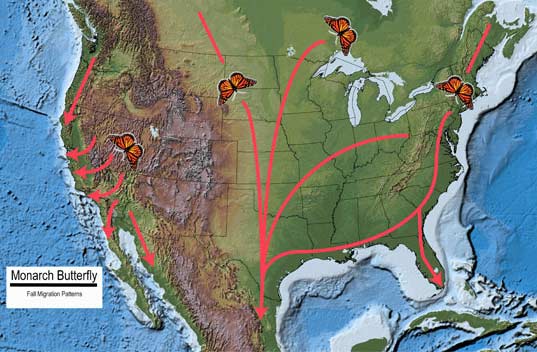
Monarchs
west of the Rockies migrate to locations on the central California
coast. Monarchs east of the Rocky Mountains, gather by the millions
to spend winter in the high mountains of central Mexico.
|
After reaching their destination, the monarchs cluster in large groups to stay warm. They can be seen resting in trees, often looking like dead leaves. When sunlight warms them enough to fly, they leave the trees to find the nectar that keeps them alive. They return to the trees before it gets cold at night. |
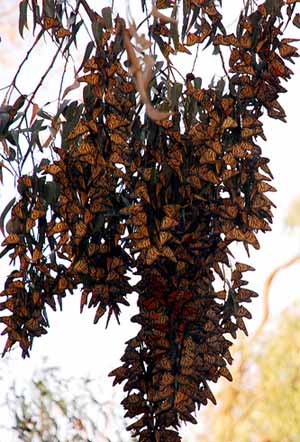
|
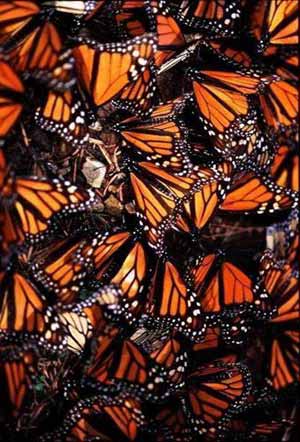 |
|
In California these butterflies are seen in the Monterey Pine and Eucalyptus trees. The Eucalyptus provide not only shelter but also nectar for food, since they bloom in winter. This nectar, which the butterflies love makes them a poisonous snack to predators. |
In February when the temperatures and daylight hours increase, right around Valentine’s Day, the Monarch butterflies can be seen performing spiral mating flights! Afterwards they form couples, rest and remain together for the night. |
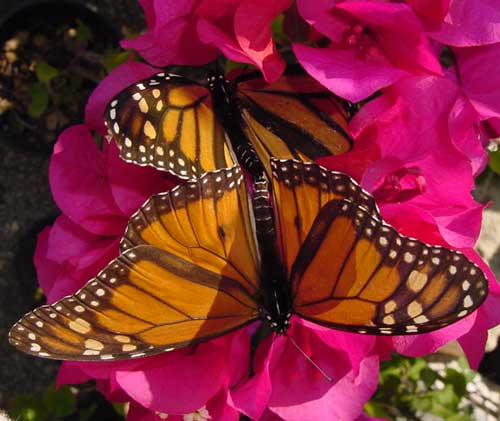
This
loving Valentine pairing provides the female with the needed nutrients
and energy to travel far in search of milkweed on which to lay her
eggs.
|
By the time March rolls around, most of the butterflies have departed on their spring migration. |
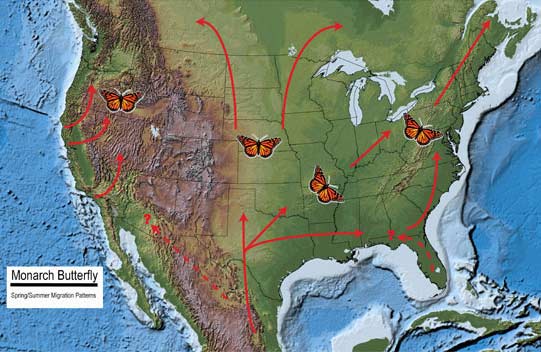
|
It's a treat for people in California to share hiking and horse riding paths with migrating Monarchs. Watch the video and see why. Video: Monarch Butterfly Migration - 02:36 minutes Did you know? Butterfly Town USA is in California! |
In the mountains of Central Mexico the butterflies that cluster in the Oyamel Fir trees are having a hard time. In February 2002 a severe winter storm killed over 200 million Monarchs! In addition the poor farmers who live here need the forest wood to survive and they are cutting down the butterfly trees. The good news is people are working together to reforest this area. Click the Oyamel Fir Tree to learn more. |
Monarchs Along the California Coast
Most monarchs west of the Rockies migrate to trees along the California coast to overwinter. The population has declined from a recorded high of approximately 1 billion butterflies in the mid-1990s to only 35 million butterflies last winter [2013], the lowest number ever recorded ... In addition to herbicide use with genetically engineered crops, monarchs are also threatened by global climate change, drought and heat waves, other pesticides, urban sprawl, and logging on their Mexican wintering grounds.
- U.S. Federal Protection Sought for Monarch Butterfly ~ Take Action. Sign the Petition.
KidZone
Fun!
Picture
Story of the Monarch's Life Cycle
Online Monarch Jigsaw Puzzles
Monarch Coloring Pages
And These, You Gotta See!
Amazing Caterpillar Transformations